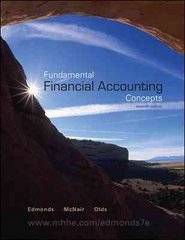Question
1. Within an enterprise, there is a selling division operating at full capacity. The manager will be willing to transfer the division's products if he
1. Within an enterprise, there is a selling division operating at full capacity. The manager will be willing to transfer the division's products if he can transfer at a price equal to his variable costs.
A. True
B. False
2. Transfer pricing concerns the setting of an internal sales price, which is a price for intermediate products transferred from profit centers to other responsibility centers within the same company.
A. True
B. False
3. If a division within a company is required to sell its product to another company division but may also sell superfluous products to outside customers, then that division is considered to be only a profit center.
A. True
B. False
4. The transfer price affects the profit of the buying and the selling divisions, but it does not affect the differential profit from a transfer for the overall enterprise.
A. True
B. False
5. A component's standard cost should be the value at which it is transferred from an enterprise's cost responsibility center.
A. True
B. False
6. Within an enterprise, there is a selling division with surplus capacity. If a transfer between divisions occurs, then the differential cost savings is computed by subtracting the floor transfer price from the ceiling transfer price.
A. True
B. False
7. An enterprise has two types of parts that can be transferred: Parts that can be sold to outside customers are called components.
A. True
B. False
8. If, within an enterprise, there is a selling division with surplus capacity, then the transfer price between divisions must be at least equal to the budgeted variable cost of transferring of both the transferring division and the receiving division.
A. True
B. False
9. Within an enterprise, there is a selling division with surplus capacity. If there is a range of transfer prices acceptable to the managers of the selling and the buying divisions, then the range is bounded by the ceiling and the floor prices.
A. True
B. False
10. If, within an enterprise, there is a selling division with surplus capacity, then the transfer price between divisions must be at least equal to the budgeted variable cost of transferring of the transferring division and no greater than the price that the receiving division would pay to an external supplier.
A. True
B. False
11. A component's actual cost should be the value at which it is transferred from an enterprise's cost responsibility center.
A. True
B. False
12. Within an enterprise, there is a selling division with surplus capacity. If a transfer between divisions occurs, then the differential cost savings is computed by subtracting the ceiling transfer price from the floor transfer price.
A. True
B. False
13. Because of problems involved with setting a transfer price, many companies allow the profit center managers to decide whether to transfer but dictate the use of a certain transfer price.
A. True
B. False
14. If a transfer occurs between an enterprise's divisions in the situation where there is a selling division with surplus capacity, then the differential cost savings is the difference in the opportunity costs of the buying and selling divisions.
A. True
B. False
15. A transfer price creates a profit for the division supplying the intermediate product.
A. True
B. False
Step by Step Solution
There are 3 Steps involved in it
Step: 1

Get Instant Access to Expert-Tailored Solutions
See step-by-step solutions with expert insights and AI powered tools for academic success
Step: 2

Step: 3

Ace Your Homework with AI
Get the answers you need in no time with our AI-driven, step-by-step assistance
Get Started


